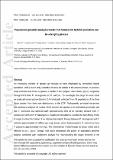Files in this item
Population genomic analysis reveals that homoploid hybrid speciation can be a lengthy process
Item metadata
| dc.contributor.author | Ru, Dafu | |
| dc.contributor.author | Sun, Yongshuai | |
| dc.contributor.author | Wang, Donglei | |
| dc.contributor.author | Chen, Yang | |
| dc.contributor.author | Wang, Tianjing | |
| dc.contributor.author | Hu, Quanjun | |
| dc.contributor.author | Abbott, Richard J | |
| dc.contributor.author | Liu, Jianquan | |
| dc.date.accessioned | 2019-11-22T00:37:05Z | |
| dc.date.available | 2019-11-22T00:37:05Z | |
| dc.date.issued | 2018-12 | |
| dc.identifier | 256346727 | |
| dc.identifier | 3ee34d21-22e2-4ca5-8ad2-d76a8a0f4a3a | |
| dc.identifier | 85056805537 | |
| dc.identifier | 000453898000015 | |
| dc.identifier.citation | Ru , D , Sun , Y , Wang , D , Chen , Y , Wang , T , Hu , Q , Abbott , R J & Liu , J 2018 , ' Population genomic analysis reveals that homoploid hybrid speciation can be a lengthy process ' , Molecular Ecology , vol. 27 , no. 23 , pp. 4875-4887 . https://doi.org/10.1111/mec.14909 | en |
| dc.identifier.issn | 0962-1083 | |
| dc.identifier.other | RIS: urn:1C292F91516E0505A6D56D8EB8393C6B | |
| dc.identifier.uri | https://hdl.handle.net/10023/18981 | |
| dc.description | This work was supported by grants from National key research and development program (2017YFC0505203), National Natural Science Foundation of China (grant numbers 31590821, 31670665, 91731301), National Key Project for Basic Research (2014CB954100), CAS “Light of West China” Program and Graduate Student’s Research and Innovation Fund of Sichuan University (2018YJSY007). | en |
| dc.description.abstract | An increasing number of species are thought to have originated by homoploid hybrid speciation (HHS), but in only a handful of cases are details of the process known. A previous study indicated that Picea purpurea, a conifer in the Qinghai–Tibet Plateau (QTP), originated through HHS from P. likiangensis and P. wilsonii. To investigate this origin in more detail, we analysed transcriptome data for 114 individuals collected from 34 populations of the three Picea species from their core distributions in the QTP. Phylogenetic, principal component and admixture analyses of nuclear SNPs showed the species to be delimited genetically and that P. purpurea was admixed with approximately 60% of its ancestry derived from P. wilsonii and 40% from P. likiangensis. Coalescent simulations revealed the best‐fitting model of origin involved formation of an intermediate hybrid lineage between P. likiangensis and P. wilsonii approximately 6 million years ago (mya), which backcrossed to P. wilsonii to form P. purpurea approximately one mya. The intermediate hybrid lineage no longer exists and is referred to as a “ghost” lineage. Our study emphasizes the power of population genomic analysis combined with coalescent analysis for reconstructing the stages involved in the origin of a homoploid hybrid species over an extended period. In contrast to other studies, we show that these stages can in some instances span a relatively long period of evolutionary time. | |
| dc.format.extent | 13 | |
| dc.format.extent | 1197675 | |
| dc.language.iso | eng | |
| dc.relation.ispartof | Molecular Ecology | en |
| dc.subject | Coalescent analysis | en |
| dc.subject | Homoploid hybrid speciation | en |
| dc.subject | Hybridization | en |
| dc.subject | Picea | en |
| dc.subject | Population genomics | en |
| dc.subject | Qinghai-Tibet Plateau | en |
| dc.subject | QH301 Biology | en |
| dc.subject | DAS | en |
| dc.subject.lcc | QH301 | en |
| dc.title | Population genomic analysis reveals that homoploid hybrid speciation can be a lengthy process | en |
| dc.type | Journal article | en |
| dc.contributor.institution | University of St Andrews. School of Biology | en |
| dc.identifier.doi | https://doi.org/10.1111/mec.14909 | |
| dc.description.status | Peer reviewed | en |
| dc.date.embargoedUntil | 2019-11-22 |
This item appears in the following Collection(s)
Items in the St Andrews Research Repository are protected by copyright, with all rights reserved, unless otherwise indicated.

